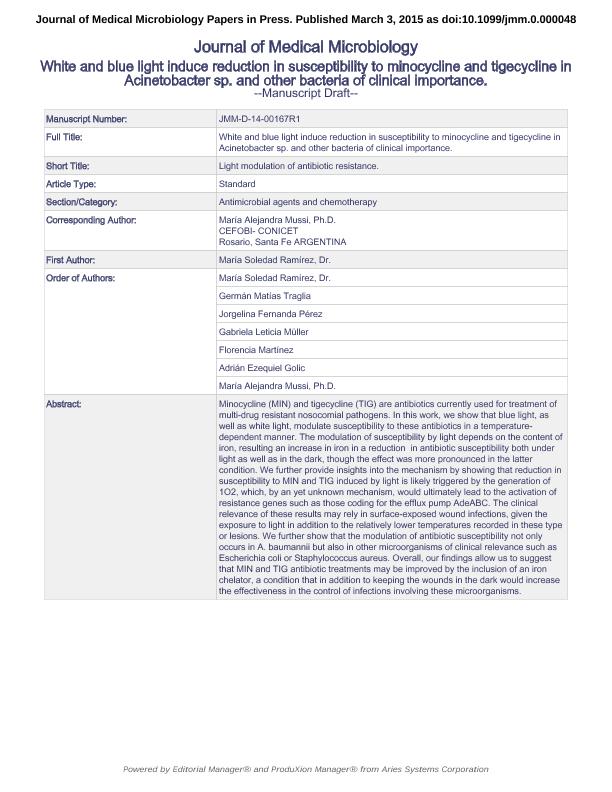Mostrar el registro sencillo del ítem
dc.contributor.author
Ramirez, Maria Soledad

dc.contributor.author
Traglia, German Matias

dc.contributor.author
Pérez, Jorgelina Fernanda
dc.contributor.author
Müller, Gabriela Leticia
dc.contributor.author
Martínez, María Florencia
dc.contributor.author
Golic, Adrián Ezequiel

dc.contributor.author
Mussi, María Alejandra

dc.date.available
2016-10-28T20:19:56Z
dc.date.issued
2015-03
dc.identifier.citation
Ramirez, Maria Soledad; Traglia, German Matias; Pérez, Jorgelina Fernanda; Müller, Gabriela Leticia; Martínez, María Florencia; et al.; White and blue light induce reduction in susceptibility to minocycline and tigecycline in Acinetobacter sp. and other bacteria of clinical importance; Society For General Microbiology; Journal Of Medical Microbiology; 64; 3-2015; 525-537
dc.identifier.issn
0022-2615
dc.identifier.uri
http://hdl.handle.net/11336/7853
dc.description.abstract
Minocycline (MIN) and tigecycline (TIG) are antibiotics currently used for treatment of multi-drug resistant nosocomial pathogens. In this work, we show that blue light, as well as white light, modulate susceptibility to these antibiotics in a temperature-dependent manner. The modulation of susceptibility by light depends on the content of iron, resulting an increase in iron in a reduction in antibiotic susceptibility both under light as well as in the dark, though the effect was more pronounced in the latter condition. We further provide insights into the mechanism by showing that reduction in susceptibility to MIN and TIG induced by light is likely triggered by the generation of 1O2, which, by an yet unknown mechanism, would ultimately lead to the activation of resistance genes such as those coding for the efflux pump AdeABC. The clinical relevance of these results may rely in surface-exposed wound infections, given the exposure to light in addition to the relatively lower temperatures recorded in these type or lesions. We further show that the modulation of antibiotic susceptibility not only occurs in A. baumannii but also in other microorganisms of clinical relevance such as Escherichia coli or Staphylococcus aureus. Overall, our findings allow us to suggest that MIN and TIG antibiotic treatments may be improved by the inclusion of an iron chelator, a condition that in addition to keeping the wounds in the dark would increase the effectiveness in the control of infections involving these microorganisms.
dc.format
application/pdf
dc.language.iso
eng
dc.publisher
Society For General Microbiology

dc.rights
info:eu-repo/semantics/openAccess
dc.rights.uri
https://creativecommons.org/licenses/by-nc-sa/2.5/ar/
dc.subject
Blue Light
dc.subject
Acinetobacter Baumannii
dc.subject
Tygecicline
dc.subject
Antimicrobial Agents
dc.subject.classification
Biología Celular, Microbiología

dc.subject.classification
Ciencias Biológicas

dc.subject.classification
CIENCIAS NATURALES Y EXACTAS

dc.title
White and blue light induce reduction in susceptibility to minocycline and tigecycline in Acinetobacter sp. and other bacteria of clinical importance
dc.type
info:eu-repo/semantics/article
dc.type
info:ar-repo/semantics/artículo
dc.type
info:eu-repo/semantics/publishedVersion
dc.date.updated
2016-03-14T12:50:55Z
dc.journal.volume
64
dc.journal.pagination
525-537
dc.journal.pais
Reino Unido

dc.journal.ciudad
London
dc.description.fil
Fil: Ramirez, Maria Soledad. Consejo Nacional de Investigaciones Científicas y Técnicas. Oficina de Coordinación Administrativa Houssay. Instituto de Investigaciones En Microbiología y Parasitología Médica; Argentina. California State University; Estados Unidos
dc.description.fil
Fil: Traglia, German Matias. Consejo Nacional de Investigaciones Científicas y Técnicas. Oficina de Coordinación Administrativa Houssay. Instituto de Investigaciones En Microbiología y Parasitología Médica; Argentina
dc.description.fil
Fil: Pérez, Jorgelina Fernanda. Universidad Nacional de Rosario. Facultad de Cs.bioquimicas y Farmaceuticas. Departamento de Microbiologia; Argentina
dc.description.fil
Fil: Müller, Gabriela Leticia. Consejo Nacional de Investigaciones Científicas y Técnicas. Centro Científico Tecnológico Rosario. Centro de Estudios Fotosintéticos y Bioquímicos (i); Argentina. Universidad Nacional de Rosario. Facultad de Ciencias Bioquímicas y Farmacéuticas; Argentina
dc.description.fil
Fil: Martínez, María Florencia. Consejo Nacional de Investigaciones Científicas y Técnicas. Centro Científico Tecnológico Rosario. Centro de Estudios Fotosintéticos y Bioquímicos (i); Argentina
dc.description.fil
Fil: Golic, Adrián Ezequiel. Consejo Nacional de Investigaciones Científicas y Técnicas. Centro Científico Tecnológico Rosario. Centro de Estudios Fotosintéticos y Bioquímicos (i); Argentina
dc.description.fil
Fil: Mussi, María Alejandra. Consejo Nacional de Investigaciones Científicas y Técnicas. Centro Científico Tecnológico Rosario. Centro de Estudios Fotosintéticos y Bioquímicos (i); Argentina. Universidad Nacional de Rosario. Facultad de Ciencias Bioquímicas y Farmacéuticas; Argentina
dc.journal.title
Journal Of Medical Microbiology

dc.relation.alternativeid
info:eu-repo/semantics/altIdentifier/url/http://jmm.microbiologyresearch.org/content/journal/jmm/10.1099/jmm.0.000048#tab2
dc.relation.alternativeid
info:eu-repo/semantics/altIdentifier/doi/http://dx.doi.org/10.1099/jmm.0.000048
Archivos asociados
